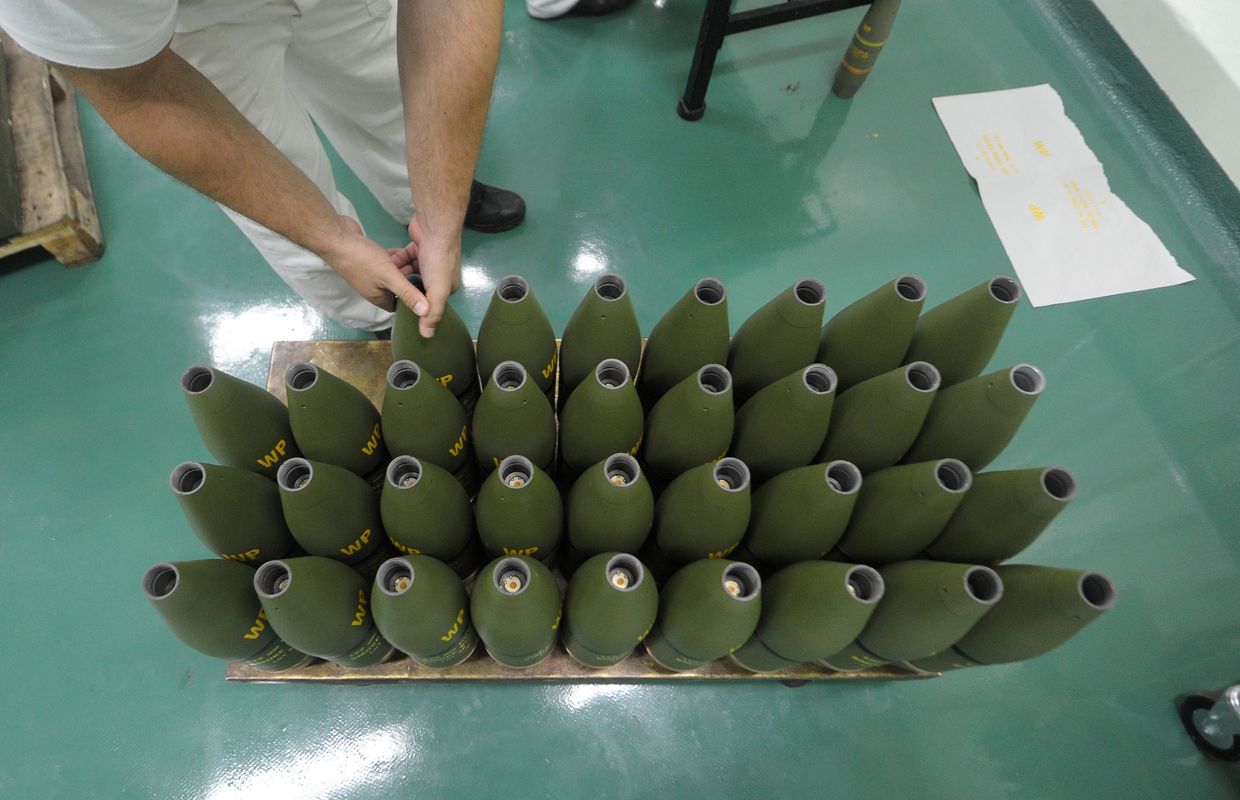No shade to dumbbells, but if you're ready to take your fitness training up a peg, investing in a good set of weight plates is the logical next step. The best weight plates align with your budget and lifting needs. For example, cast iron plates are a no-brainer for durability and affordability, while rubber plates are a must for powerlifters who need to drop their weights from a height. Whatever your style, weight plates can transform your home setup into a professional-level workout space.
Cassandra Padula Burke, a certified public trainer, agrees, saying, "[Weight plates] can be used on a barbell but can also be used independently for exercises like overhead triceps extensions, Russian twists and shoulder presses." She also highlights that weight plates are perfect for strength building, allowing you to add heavier plates as you get stronger. "Weight plates allow you to progressively load muscles to improve strength and build muscle," she says. Plus, they're space-efficient. "They are easy to store and don't take up as much space as an equivalent variety of dumbbells would," she adds.
Ready to create a gym-quality lifting experience at home? You'll need three key pieces of equipment: a sturdy weight bench, a good-quality barbell and a set of weight plates. If you're unsure of what to buy or how to start, there's good news: We did the heavy lifting for you. Over six months, we rigorously tested five sets of weight plates, including rubber, cast iron and Olympic options. We also gathered expert insights from professional personal trainers and powerlifters and drew from our own experiences as lifters to inform our recommendations.
Best overall weight plates
More weight plates we like in 2025
Types of plate weights
Thanks to their versatility, weight plates can be used on their own for functional training or paired with a barbell for compound lifts. Whether made from iron, steel or rubber, each type serves a purpose — from powerlifting to CrossFit. Here's a breakdown of the primary options:
Standard weight plates: Designed for a standard barbell with a 1-inch diameter, these plates are best suited for casual or beginner lifters.
Olympic plates: These plates fit Olympic barbells with a 2-inch diameter. They can be made from steel, iron or rubber and are known for their high weight accuracy, making them a staple for serious strength training.
Training plates: Often lighter and available in smaller weight increments, like 2.5 and 5 pounds, training plates are perfect for beginners or those refining their technique and form. Because of their low weight, they help lifters gradually increase strength while focusing on proper movement patterns.
Bumper plates: Thicker and more shock-absorbent than traditional plates, bumper plates are designed for exercises like deadlifts and those performed during CrossFit workouts where weights are frequently dropped from thigh height. These plates are made from all rubber or with a rubber coating over a steel or iron core, offering durability and safety.
Competition and powerlifting plates: These plates are engineered for maximum weight accuracy and precision. They're typically reserved for high-level strength competitions.
Factors to consider when purchasing weight plates
The best weight plates for your home gym depend on your goals, space and how you like to train — whether you're chasing PRs (personal records) or you're just trying to challenge yourself on leg day. Here's what our experts say you should keep in mind when picking your plates:
Durability
According to Burke, durability is an important factor, though it may be outweighed (no pun intended) by other considerations, like your workout space and budget. Still, when possible, opt for weight plates designed to withstand regular use. Cast iron and steel plates, for example, are incredibly durable and have been trusted since the 19th century, but they can be noisy and may damage floors or walls if dropped.
Rubber-coated plates are quieter and less likely to cause damage, making them a good choice for apartments or shared living spaces. Burke explains that rubber plates are still highly durable because they often have an internal iron or steel core for added strength.
Construction and calibration
High-quality construction and accurate calibration are key. "Weight plates should be accurate within 1% to 2% of the specified weight," Burke notes. This accuracy ensures consistent training and prevents imbalances — for instance, poorly calibrated weights could cause problems when loaded on a barbell, causing discrepancies in load between one side and the other. Many manufacturers list their plates' weight calibration online, but you can also contact the company before purchasing to double-check.
For serious lifters or those aiming for precise progression, Raymond Agostino, physical therapist and sports performance coach, recommends competition-grade plates with a weight accuracy to within 0.5%. However, he adds that standard weight tolerance is adequate for most home gym setups.
Burke also points out that poor construction and damage to the plate, such as chipping or cracking, can affect the accuracy of the weight. "Damage to the rubber coating of the plate can expose the iron underneath, making it vulnerable to corrosion, which may cause weight loss," she says. This brings us to the next consideration: material and coating.
Material
Weight plates are typically made from cast iron, steel or rubber, with some rubber plates featuring a metal core. As Agostino points out, each material has its pros and cons. "Cast iron plates are cost-effective and compact, steel plates are durable [and] rubber-coated plates are quieter and protect floors," he says.
Training and strength goals
If you're new to weight training, dumbbells may seem like a more approachable and versatile option. But trust us: weight plates are just as versatile. Noelle McKenzie, a certified physical trainer and correctional exercise specialist, explains that weight plates can double as dumbbells for exercises like chest flies, curls and raises, while also offering added functionality. Beyond their traditional use with a barbell for heavier lifts, weight plates can be used creatively for bodyweight exercises, like planks or wall sits, introducing variety and challenge to your workouts. Ultimately, how you plan to use the plates will determine the type of plates to buy and how heavy you need your weights to be.
Available space
McKenzie emphasizes that weight plates are more space-efficient than dumbbells or kettlebells, as they can be stored on a plate tree or mounted on a wall.
Application
Umo Callins, a certified physical trainer and board-certified sports dietitian, recommends choosing a weight plate based on your budget, the floor it will be used on and how the weights will be used.
"If you plan on squatting, deadlifting and doing Olympic lifts, bumper plates work best because if you drop the bar, the plates will have some level of bounce," she says. "Plus, as long as your bar has a high whip grade, they will not bend your bar over time."
Overall, bumper plates are Callins's go-to recommendation. "Bumper plates are easier on your flooring, not loud when dropped and allow you to do more varieties of barbell training," she notes.
Budget
While top-tier Olympic weight plates aren't necessary for most home gyms, going too cheap may sacrifice durability and end up costing more over time. Ideally, opt for a good-quality, durable set made by a reputable manufacturer. Depending on the brand, some plates are covered under warranty, providing additional peace of mind.
How we chose
To determine the best weight plates for every fitness level, two professional personal trainers, several powerlifters and a diverse group of casual gym-goers of varying ages and abilities rigorously tested five weight sets, providing a well-rounded perspective on each plate's performance. The plates were used regularly over six months to assess their durability and reliability with repeated use in home and commercial gym environments. Each set was evaluated based on its materials, durability, performance and overall value.
Our final list was determined using a combination of tester feedback, expert insights from personal trainers and our own lifting experience.
FAQs
What type of weight plates do I need for my barbell?
Most weight plates are designed to fit either a standard barbell with a 1-inch diameter or an Olympic barbell with a 2-inch diameter. If you’re unsure, check the manufacturer’s specifications to confirm compatibility. For added assurance, consider purchasing a coordinated set of plates and barbells to guarantee a perfect fit.
What's the difference between cast iron, steel and rubber-coated plates?
Cast iron and steel plates are highly durable and built to last, but they’re not intended to be dropped during workouts. In contrast, rubber-coated plates are designed for high-impact movements like deadlifts and snatches, safely absorbing the force when dropped on the ground. This makes them ideal for more dynamic training styles.
How accurate should my weight plates be?
Most weight plates should be accurate within their reported 1% to 2% range. Some manufacturers also list the weight plate calibration for accuracy. On our list, for instance, Ethos reports that its weight plates are calibrated to +0.1% to -0.05% of 20 kg.
How do I care for and maintain my weight plates?
Metal plates can be wiped down with a cloth, dried and occasionally treated with WD-40 to prevent rusting. Rubber plates can be cleaned using mild dish soap and water, then towel-dried. To prolong the life of all weight plates, avoid exposing them to excess moisture or humidity and store them off the floor whenever possible.
What safety precautions should I take when using weight plates?
Always use reliable equipment and regularly inspect weight plates for signs of damage, such as cracks or chips. When lifting a barbell, prioritize safety by using equipment like clips or collars, racks and safety arms and enlist a spotter whenever possible. It's also important to take care when storing weights. Improperly stacked plates can pose a falling hazard or result in pinched fingers. To minimize risks, use a plate tree or designated storage system.
Meet our experts
Raymond Agostino, DPT, sports performance coach and owner of Agostino Athletics in Fort Myers, Fla.
Cassandra Padula Burke, MFS, RDN, CPT, owner of Catalyst Performance Lab in Finksburg, Md.
Umo Callins, MS, RD, LD, CSSD, CPT, a sports dietitian and fitness coach based in Oklahoma City, Okla.
Noelle McKenzie, CPT, correctional exercise specialist and co-founder of Leading Edge Personal Trainers in New York,
Tim Strunk, CPT, former head trainer at Eighty Twenty Club in Lapeer, Mich.
Jason Wrosch, CPT, head trainer at Eighty Twenty Club in Lapeer, Mich.
Our health content is for informational purposes only and is not intended as professional medical advice. Consult a medical professional on questions about your health.
.png)
 German (DE)
German (DE)  English (US)
English (US)  Spanish (ES)
Spanish (ES)  French (FR)
French (FR)  Hindi (IN)
Hindi (IN)  Italian (IT)
Italian (IT)  Russian (RU)
Russian (RU) 



Comments